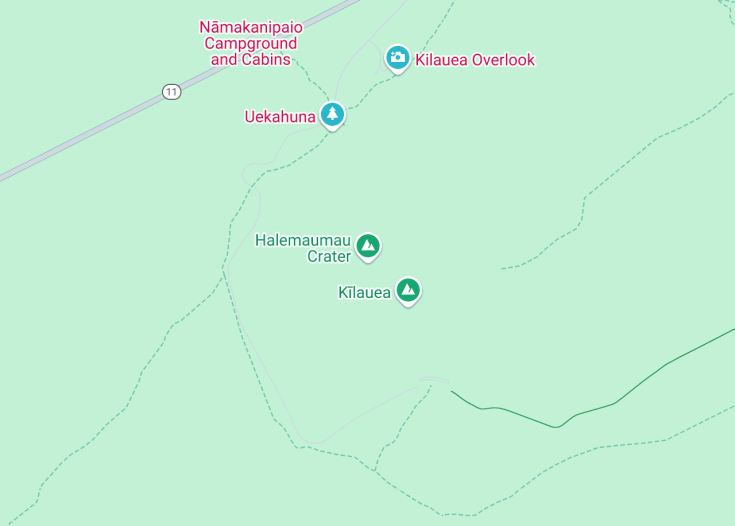Nestled within the larger summit caldera of Kīlauea in Hawaii Volcanoes National Park, Halemaumau Crater is a dynamic and historically significant volcanic feature. This crater has been a prominent site in both Hawaiian culture and modern volcanology, offering an exceptional view of Kilauea’s ongoing volcanic activity. Recent eruptions have reshaped its landscape, making Halemaumau a must-see for those interested in natural phenomena and geological processes.
Before visiting, check the park’s website for the latest volcanic activity reports and closures to ensure a safe viewing experience of Halemaumau Crater.
Consider visiting at dawn or dusk for a mesmerizing view of the glowing lava against the twilight sky, enhancing the dramatic and natural beauty of Halemaumau.
Halemaumau Crater: A volcanic marvel
The Halemaumau Crater, located within the Hawai’i Volcanoes National Park on the Big Island, is not just a geographical feature but a site rich with cultural and natural significance. This crater holds a special place in Hawaiian culture as the traditional home of Pele, the goddess of fire and volcanoes. A visit to Halemaumau offers more than just spectacular scenery; it’s a journey into the heart of Hawaiian folklore and natural power.
Over the years, Halemaumau has been the site of frequent volcanic activity, creating a dynamic and ever-changing landscape that attracts scientists and tourists alike. Recent eruptions have reshaped its contours and expanded its boundaries, offering a once-in-a-lifetime opportunity to witness the raw force of Earth’s geology up close. The viewing platform near the crater provides visitors with breathtaking views of the crater’s glowing lava lake, especially stunning during the night. Emphasizing on educational aspects, the park provides detailed information on volcanic activity and its impacts on surrounding ecosystems, making it not only a picturesque stop but also a significant learning experience.
Exploring the depths of Halemaumau
Visitors to Halemaumau Crater can engage in a variety of activities that enhance both their understanding and appreciation of this geological wonder. Walk along the edges of the crater through well-marked trails that offer panoramic views and opportunities for phenomenal photography. The overlooks are particularly popular at sunrise and sunset, when the colors of the sky dramatically contrast with the earthy tones of the volcanic landscape.
Guided Tours
Engaging with knowledgeable guides through guided walking tours helps visitors delve deeper into the history and science behind the volcanic activity. These tours often include discussions on local flora and fauna, adding a biological perspective to the geological experience.
The ever-changing spectacle of Halemaumau
Halemaumau Crater is renowned for its remarkable transformation over recent years. The crater floor, once a solid expanse, has dramatically subsided and collapsed, creating a vastly enlarged pit that is slowly being refilled by a growing lava lake. This natural phenomenon provides a unique opportunity for visitors to observe firsthand the processes that shape our planet. The resilience and adaptation of the local wildlife to these volatile conditions are also of significant interest, showcasing the interplay between geology and biology.
Discover the majestic Halemaumau Crater
The Halemaumau Crater is a captivating destination suitable for all ages, from enthusiastic geologists and nature lovers to adventure-seeking families. Visitors can expect a unique geological wonder, offering a rare glimpse into the heart of a volcanic caldera.
For couples seeking a romantic escape, the crater provides breathtaking vistas, especially during sunrise or sunset. Older visitors will appreciate nature trails with informative displays about the volcanic landscape and its ecological significance. Children and students will be thrilled with the opportunity to learn about Earth sciences in such a vivid natural laboratory.
The best time to experience Halemaumau Crater
Visiting the Halemaumau Crater can be a mesmerizing experience year-round, but the best time to visit is during the dryer months from May to October. During this period, clearer skies and lower precipitation levels ensure optimal viewing of the crater’s features and surrounding landscapes.
Seasonal events
If timing your visit with local events, consider the Vibrant Volcano Festival, held annually in July. This event features walks, talks, and cultural demonstrations that enrich the experience.
Understanding Accessibility and Limitations at Halemaumau Crater
While Halemaumau Crater is a must-visit, it comes with certain accessibility and limitations that visitors should note.
Accessibility
Limitations
- Drone flying is prohibited to prevent disturbances to the natural ecosystem.
- Entrance to some sections may be restricted due to volcanic activity or weather conditions.
- Limited mobile network availability within the conservation area.
Notes to visitors
- Be sure to bring water and sun protection as shade is limited.
- Stay on marked trails to preserve the fragile volcanic landscape.
- Evening temperatures can drop significantly; bringing a jacket is advisable.
General informations
Essential details for your visit to Halemaumau Crater.
Location and Access
The crater is near several key transport hubs, making it accessible by a variety of transportation means. Popular attractions and accommodation facilities around the area use it as a reference point.
Address: Main entrance at Volcano National Park, Crater Rim Drive, HI.
Opening hours
The Halemaumau Crater is open year-round, from 6 AM to 9 PM. Certain areas may close temporarily for safety concerns related to volcanic activity.
Getting to Halemaumau Crater
Car
Traveling by car is the most convenient way to visit. There is ample parking available near the visitor’s center.
| Route | Distance | Travel time |
|---|---|---|
| From Hilo | 30 miles (48Km) | 45 minutes |
| From Kona | 96 miles (155Km) | 2 hours, 15 minutes |
| From Waikoloa Village | 70 miles (113Km) | 1 hour, 50 minutes |
Public Transit
Buses run from major towns like Hilo and Kona, offering a scenic ride to the crater with several stops in between.
Nearby Attractions
- Volcano Art Center – 2 miles (3.2 km)
- Kilauea Visitor Center – 1 mile (1.6 km)
- Thomas A. Jaggar Museum – 0.5 miles (0.8 km)
- Lava Tree State Monument – 25 miles (40.2 km)
- Akatsuka Orchid Gardens – 3 miles (4.8 km)
- Rainforest Zoo – 15 miles (24.1 km)
- Black Sand Beach – 24 miles (38.6 km)
- Green Sand Beach – 40 miles (64.4 km)
- Mauna Loa Macadamia Nut Farm – 16 miles (25.7 km)
- Historic Banyan Drive – 28 miles (45 km)
- Liliuokalani Gardens – 30 miles (48.3 km)
- Hilo Farmers Market – 32 miles (51.5 km)
Common questions
What is the geological significance of Halemaumau Crater?
What type of volcanic activity can be seen at Halemaumau Crater?
How safe is it to visit Halemaumau Crater?
What is the cultural significance of Halemaumau Crater to the Native Hawaiian people?
What wildlife might one encounter near Halemaumau Crater?
Are there guided tours available for Halemaumau Crater?
What are the best viewpoints for observing Halemaumau Crater?
What hiking opportunities are available around Halemaumau Crater?
How has Halemaumau Crater changed in recent years?
Can you see lava at Halemaumau Crater?
What steps are being taken to preserve Halemaumau Crater?
What facilities are available for visitors at Halemaumau Crater?

Is the Halemaumau crater in Volcano worth visiting?
Visiting the Halemaumau crater at Hawaii’s Volcanoes National Park is a highly rewarding experience for both geology enthusiasts and tourists alike. This active crater within Kilauea’s summit caldera is not only a significant site from a scientific standpoint but also offers incredible vistas and insights into the natural processes shaping our Earth.
However, potential visitors should be aware that accessibility to the crater can vary depending on volcanic activity and weather conditions, which might affect visibility. While the site is equipped with safety measures, the robustness of these can differ, and it’s important to check current conditions with park authorities before planning a visit.










